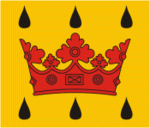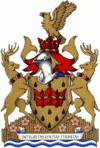Leduc (Leduc)
 |
 |
Leduc was established in 1891, when Robert Telford, a settler, who had bought land, in 1889, near a lake which would later bear his name. It was on that piece of land where the new settlement would take root. Telford established a stopping place for the stagecoach line that in 1889 connected Calgary to Edmonton. It became known as Telford's Place. Telford previously served as an officer for the North-West Mounted Police, and later became Leduc's first postmaster, first general merchantman, and first justice of the peace. He was also elected to serve as Leduc's first Member of the Alberta legislature (MLA)in 1905.
The establishment of the Calgary and Edmonton Railway, later acquired by the Canadian Pacific Railway, opened the region to settlement. The first train stopped at Leduc in July 1891.
Originally there were two versions to describe how Leduc got its name. In fact both accounts are true. In April 1886 when a settler (McKinley) setting up a telegraph office needed a name for the new station and decided that it would be named after the first person who came through the door of the telegraph office. That person was Father Hippolyte Leduc, a priest who had served the area since 1867. Five years later, in 1891, the Minister of the Interior and Superintendent of Indian Affairs, who had been Lieutenant-Governor of the North-West Territories, Edgar Dewdney (1835–1916), was given a list of names, that had been provided to the railroad by Father Lacombe, decided that Telford Place should be renamed at the time the railway terminal was being established. Father Leduc's name was on the list and since the telegraph station was already called Leduc Dewdney saw no reason why not to use Leduc's name for the new railroad station and the hamlet that was growing alongside.
Leduc was incorporated as a village in 1899, and became a town in 1906. It became a city in 1983; by that time its population had reached 12,000.
The town continued to grow quietly over the decades and Alberta's historical oil strike on February 13, 1947, occurred near the town at the Leduc No. 1 oil well.
Map - Leduc (Leduc)
Map
Country - Canada
 |
 |
| Flag of Canada | |
Indigenous peoples have continuously inhabited what is now Canada for thousands of years. Beginning in the 16th century, British and French expeditions explored and later settled along the Atlantic coast. As a consequence of various armed conflicts, France ceded nearly all of its colonies in North America in 1763. In 1867, with the union of three British North American colonies through Confederation, Canada was formed as a federal dominion of four provinces. This began an accretion of provinces and territories and a process of increasing autonomy from the United Kingdom. This widening autonomy was highlighted by the Statute of Westminster 1931 and culminated in the Canada Act 1982, which severed the vestiges of legal dependence on the Parliament of the United Kingdom.
Currency / Language
| ISO | Currency | Symbol | Significant figures |
|---|---|---|---|
| CAD | Canadian dollar | $ | 2 |
| ISO | Language |
|---|---|
| EN | English language |
| FR | French language |
| IU | Inuktitut |















